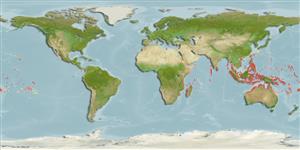Common names from other countries
>
Beloniformes (Needle fishes) >
Zenarchopteridae (Internally fertilized halfbeaks)
Etymology: Zenarchopterus: Particle zen, derived from zao = to give life + Greek, archos = anus + Greek, pteron = fin.
More on author: Valenciennes.
Environment: milieu / climate zone / depth range / distribution range
Οικολογία
Θαλασσινό(ά); Γλυκού νερού; Υφάλμυρο Υφαλόφιλο(α); pH range: 7.0 - 8.0; dH range: 10 - ?; ωκεανόδρομο(ς) (Ref. 51243); εύρος βάθους 0 - 3 m (Ref. 86942). Tropical; 24°C - 28°C (Ref. 12468)
Indo-Pacific: Kenya, Mozambique, Seychelles, Madagascar, New Guinea, Solomon Islands, Australia, New Caledonia, Fiji, and Samoa. Reported from Sri Lanka (Ref. 6028) and Vanuatu (Ref. 13300). Also found in India, Malaysia, Thailand and Singapore (Ref. 43081).
Μέγεθος / Βάρος / Age
Maturity: Lm ? range ? - ? cm
Max length : 19.0 cm TL αρσενικό/απροσδιόριστο; (Ref. 7050)
Short description
Κλείδες προσδιορισμού | Μορφολογία | Μορφομετρία
Ραχιαίες άκανθες (συνολικά) : 0; Μαλακές ραχιαίες ακτίνες (συνολικά) : 11 - 12; Εδρικές άκανθες: 0; Μαλακές εδρικές ακτίνες: 12 - 13; Σπόνδυλοι: 42 - 43. Upper jaw distinctly wider than long. Snout uniform brown without any dark band on the midline. Pectoral fin shorter than head length. Lower jaw much shorter than head. Sixth and seventh anal rays of adult males greatly thickened and elongated, both rays reaching beyond the caudal base. Either dorsal ray 4 or 5 or both elongated and thickened.
Inhabit shallow water around mangrove in sheltered bays (Ref. 26367). Early juveniles are neustonic and float on the surface of estuarine mangroves (Ref. 43081).
Life cycle and mating behavior
Maturities | Αναπαραγωγή | Spawnings | Egg(s) | Fecundities | Προνύμφες
Collette, B.B., 1986. Hemiramphidae. p. 163-164. In J. Daget, J.P. Gosse and D.F.E. Thys van den Audenaerde (eds.) Check-list of the freshwater fishes of Africa (CLOFFA). ISNB, Brussels; MRAC, Tervuren; and ORSTOM, Paris. Vol. 2. (Ref. 6798)
IUCN Red List Status (Ref. 130435)
CITES (Ref. 128078)
Not Evaluated
Threat to humans
Harmless
Human uses
αλιεία: Εμπορικό(ά)
Εργαλεία
Special reports
Download XML
Διαδικτυακές πηγές
Estimates based on models
Preferred temperature (Ref.
115969): 26.2 - 29.3, mean 28.6 (based on 2318 cells).
Phylogenetic diversity index (Ref.
82804): PD
50 = 0.5000 [Uniqueness, from 0.5 = low to 2.0 = high].
Bayesian length-weight: a=0.00457 (0.00200 - 0.01044), b=3.03 (2.83 - 3.23), in cm Total Length, based on LWR estimates for this (Sub)family-body shape (Ref.
93245).
Τροφικό Επίπεδο (Ref.
69278): 2.9 ±0.5 se; based on size and trophs of closest relatives
Fishing Vulnerability (Ref.
59153): Low vulnerability (10 of 100).
